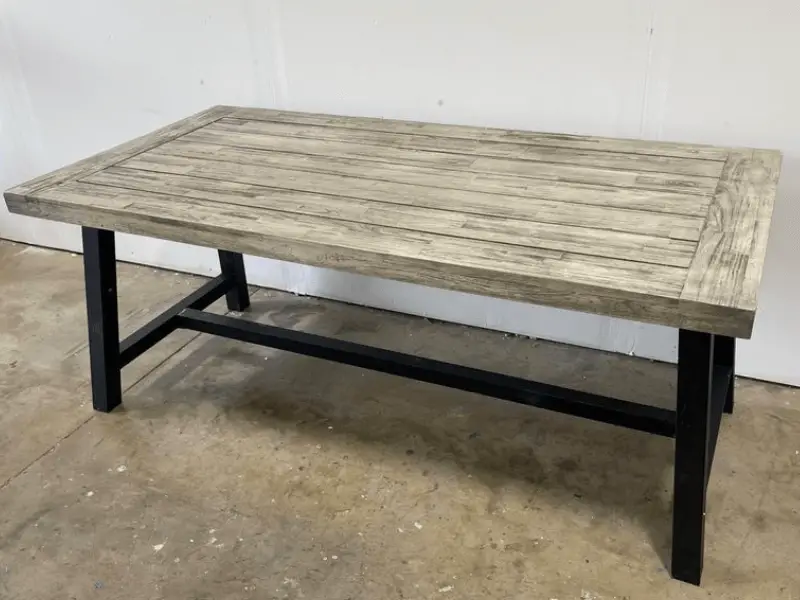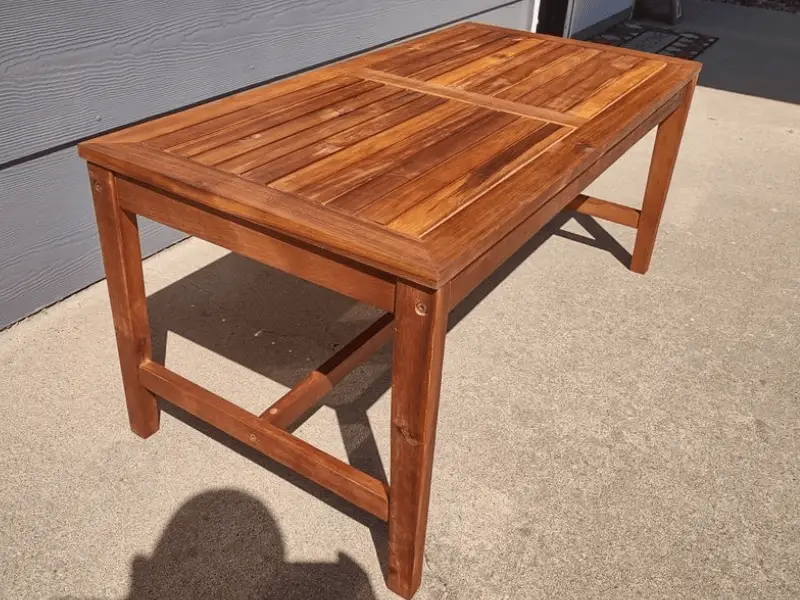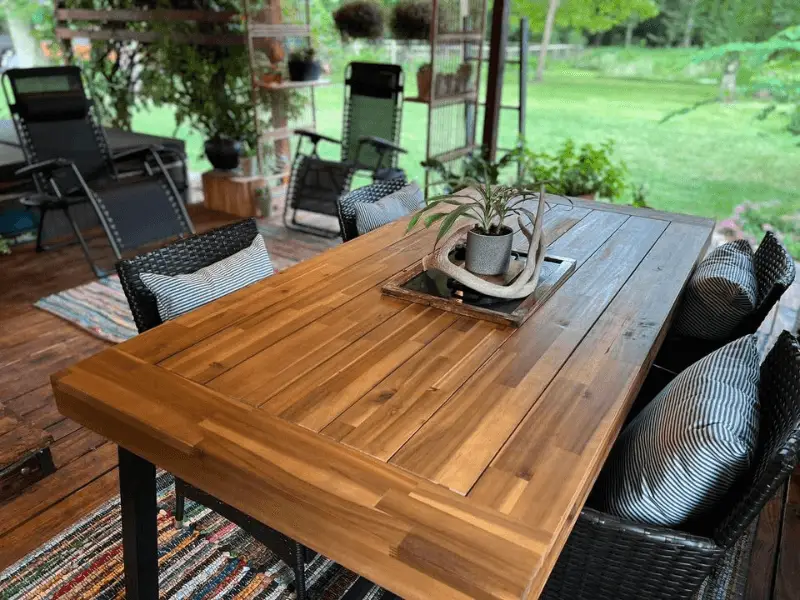Transforming your outdoor space into a stunning oasis of comfort and style begins with the right choice of material. Acacia wood, known for its remarkable durability and natural beauty, emerges as an exceptional option for outdoor furniture. However, to ensure its longevity and retain its exquisite appearance, proper treatment is essential. In this guide, we unveil the secrets to effectively treating acacia wood for outdoor furniture, allowing you to bask in the pleasures of a welcoming and resilient outdoor retreat for years to come.
Does acacia wood last outdoors

Yes, acacia wood is known for its durability and ability to withstand outdoor conditions. When properly treated and maintained, acacia wood can last for many years in outdoor settings. Its natural resistance to rot, decay, and pests make it a popular choice for outdoor furniture, decking, and other outdoor applications. However, it is important to note that even though acacia wood is naturally durable, it still requires regular maintenance and protection, as discussed below.
Best Finishing to Treat Outdoor Acacia Furniture
Best stain for acacia wood
Stain+sealer are popular options for many outdoor projects due to their convenience. They combine the processes of staining, sanding, and sealing into one, making them efficient choices. This efficiency is especially beneficial for finishing decks. Your acacia furniture could greatly benefit from this combination. The stain will enhance the vibrance of the acacia wood, allowing you to choose the perfect shade. Additionally, the sealer will lock in the stain and provide essential protection for the wood, ensuring its longevity. This versatile option is ideal for anyone looking to alter the color of their acacia furniture while simultaneously providing crucial protection.
Ready Seal Exterior Stain and Sealer is the go-to choice for achieving a stunning finish on your exterior wood surfaces. With its exceptional features and "goof proof" application, it takes the hassle out of staining and sealing, giving you professional results without the need for primers or complicated techniques.
Best sealer for acacia wood
Applying a polyurethane finish, whether oil-based or water-based, can provide added protection to acacia wood furniture. Polyurethane forms a durable and protective layer on the surface of the wood, guarding against moisture, water damage, and rot. It helps to prevent swelling, warping, and decay, thus enhancing the longevity of the furniture.
General Finishes Exterior 450 Water-Based Topcoat is the ultimate solution for durable and water-based polyurethane finishes. Specifically designed for outdoor projects, this exceptional clear coat provides unparalleled protection against moisture damage, including warping, swelling, and rot. With its mold-resistant properties, it defends against the growth of mold and mildew caused by moisture. The incorporation of UV absorbers ensures that your outdoor wood retains its vibrant color and resists fading from sun exposure. Choose General Finishes Exterior 450 Water-Based Topcoat for reliable and long-lasting protection, making your outdoor projects stand the test of time.
Top Qualities
- Durable
- Low odor
- Fast drying
- UV absorbers
Best oil for acacia wood outdoor furniture
When it comes to choosing the best oil for acacia wood outdoor furniture, there are several options to consider. Here are a few popular choices:
- Teak oil: Teak oil is a common choice for outdoor furniture, including acacia wood. It penetrates the wood fibers, nourishing and protecting the wood while enhancing its natural color and grain. Teak oil also provides some level of water resistance and helps to prevent the wood from drying out or cracking.
- Danish oil: Danish oil is another popular option for treating outdoor furniture. It typically consists of a blend of tung oil and varnish or other protective resins. Danish oil penetrates the wood, providing moisture resistance and enhancing the wood’s natural appearance. It creates a durable finish that helps protect the acacia wood from weathering.
- Linseed oil: Linseed oil, derived from flaxseed, is a traditional choice for protecting and enhancing the beauty of wood. It penetrates the wood and provides a natural, low-sheen finish. Linseed oil offers some water resistance but may require more frequent reapplication compared to other options.
Before applying any oil, it is recommended to clean the acacia wood thoroughly and ensure it is dry. Additionally, always follow the specific instructions provided by the oil manufacturer, as application techniques and drying times can vary. Regular maintenance and reapplication of the oil will help to maintain the wood’s appearance and protection over time.
How to seal acacia wood table
Step I: Prepare the Poly & Furniture
If the wooden fitting has been outside for a long time, ensure it is fully dry. Once dry, wipe off any debris with a tack cloth. If there are stubborn stains, such as bird droppings, use mild water and a detergent solution to wash them off gently. Afterward, use a 150-grit hand scuff to smoothen the wood’s surface.
To prepare the poly, start by stirring the can of poly to get a consistent finish. Avoid shaking the can as this will create air bubbles which will leave splotches or bumps on the wood surface. If you find the poly is inconsistently thick, you should consider thinning it out with a viable solvent, most notably mineral spirits, at a ratio of 3:1.
Step II: Apply the First Coat
Use a clean cloth or brush to apply the poly. This finish has a self-leveling property, thus you should not focus much on attaining an even coat. Simply apply a thin coat using long strokes and spread it out on the furniture’s surface. It is prudent to apply from side to side to ensure equal distribution. Also, as explained in our outdoor wood treatment guide, make sure to apply more poly on the end grains as these are the most absorbent sections of the fitting.
Step III: Smoothen Surface & Apply Second Coat
Give the semi-gloss oil-based poly 24 hours to dry before applying another coat. Once dry, remove any imperfections using a sharp razor or gently rub them down using 400-grit sandpaper. Be extra cautious not to scuff the surface and even out any drips before they dry up. Wipe away the shavings and proceed to apply a second coat using long, side-to-side strokes.

Unlike water-based poly which requires several coats, two coats are enough for oil-based poly. However, you can add more coats if you feel the finish is not yet desirable.
Conclusion
Although it is a beautiful and sturdy exotic hardwood ideal for outdoor furniture, acacia wood is also very sensitive to natural elements. Therefore, it is important to treat the wood to prevent it from weathering. Semi-gloss oil-based polyurethane finishing is the best treatment option for acacia since it allows the wood’s natural beauty to shine through, maintaining the wood’s character, and offering ample protective coating from the elements.
Frequently Asked Questions: Treating Acacia for outdoor
Is acacia wood waterproof?
No acacia wood is not waterproof and will need protection against water damage. You can use a waterproof sealant or finish to protect acacia wood from moisture. Applying a coat of waterproof sealant can help create a barrier that prevents water from penetrating the wood and causing damage such as warping, swelling, or rotting. It is important to note that while a waterproof sealant can provide some level of protection, it is still recommended to avoid prolonged exposure to water and to clean up spills promptly to maintain the wood’s integrity.
Can I put polyurethane on acacia wood?
Yes, you can apply polyurethane on acacia wood. It is recommended to sand the surface of the wood smoothly before applying polyurethane to ensure a smooth and even finish.
How long can acacia last outdoor
Acacia wood can last anywhere from 5 to 15 years or more. To extend the lifespan of acacia wood outdoors, it is important to choose high-quality wood and protect it from extreme weather and other environmental conditions with appropriate finishes, such as a weather-resistant sealant.
Is acacia wood good for outdoor furniture?
Acacia wood can be a good option for outdoor furniture as it is naturally weather-resistant and durable. However, its quality and resistance to outdoor elements can vary depending on the specific species of acacia and where it is grown, so it is important to choose high-quality acacia wood and treat it with appropriate wood finishes to extend its lifespan.



